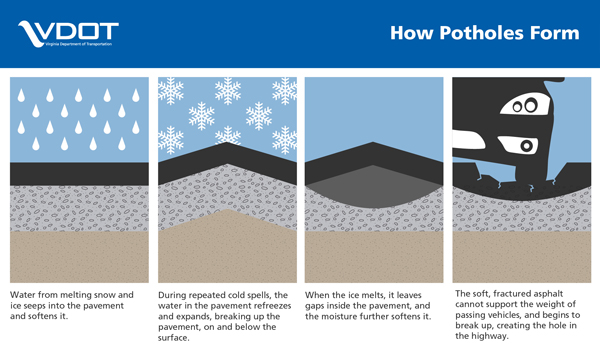Potholes
If you encounter a pothole, report it to VDOT.
Virginia Department of Transportation (VDOT) crews work quickly to repair potholes following winter storms and spring rain.
What is VDOT Responsible For?
VDOT and its interstate maintenance contractors are responsible for patching potholes on the 58,000 miles of state-maintained roadways in the commonwealth.
VDOT is committed to patching potholes as soon as possible, especially those in travel lanes.
Who Can I Call to Report a Pothole?
If you encounter a pothole on a state-maintained road, report the problem here. You can also call 1-800-FOR-ROAD (1-800-367-7623) to report any road maintenance issues.
If the pothole is in a city, town or Arlington or Henrico counties, call the public works department in that location.
Crews will investigate each report and will schedule repairs as soon as possible.
What Makes a Pothole?
Potholes are created when moisture seeps into the pavement, freezes, expands and then thaws.
This weakens the pavement. Traffic loosens it even more, and it eventually crumbles and pops out.
Why Do So Many Potholes Occur in the Spring?
Spring temperatures warm the cold pavement, melting and evaporating ice. This creates air pockets that can eventually cause the pavement to break up. A winter of heavy snow or rain and several freeze-thaw cycles can mean a big pothole season ahead.
How Are Potholes Repaired?
The pothole is carved out with a jackhammer or masonry saw to create a neat rectangle. When the excess asphalt is removed, an adhesive is applied and asphalt is added in layers. It is leveled off and compacted with a pavement roller.
In some counties, VDOT uses "pothole killers," machines that fix potholes quickly without closing the road. Learn more here.
You Filled a Pothole, But a Few Days Later It Came Back. Why Don’t Repairs Last Longer?
There are several reasons why a newly filled pothole may reopen:
- When conditions are cold or wet, the material used to patch potholes doesn’t stick as well to the surrounding pavement as when conditions are dry and warm.
- During winter months, asphalt plants are closed and hot asphalt is not available until spring. In the meantime, we typically use a material called “cold mix,” which isn’t always as durable.
- If the cause of the pothole is not corrected, i. e. water getting under the pavement, pothole patches may fail, or more potholes may form. The long-term solution is to repair and repave the road.
Ultimately, our goal is safety and we must repair potholes as soon as possible.
Do Some Roads Have More Potholes Than Others?
Roads with high traffic volumes have more potholes because of of heavier use. Bridges and ramps, which receive heavy doses of snow-removal chemicals, are more prone to potholes.
Can Anything Be Done to Prevent Potholes?
Roads today are built to reduce their moisture capacity. Researchers are working to develop better, more durable pavement materials and designs.
Researchers also have improved the cold-patch asphalt so those patches last longer.
Can I File a Claim for Damage to My Vehicle?
If a driver hits a pothole and experiences damage to their vehicle, they have a legal right to submit a damage claim.
Claims are investigated on a case-by-case basis.
Investigators review the circumstances, the type and location of the pothole, if VDOT had been previously notified of the issue, and if crews had been given a reasonable amount of time to repair the pothole.
To submit a claim for damage to your vehicle, visit https://my.vdot.virginia.gov.




